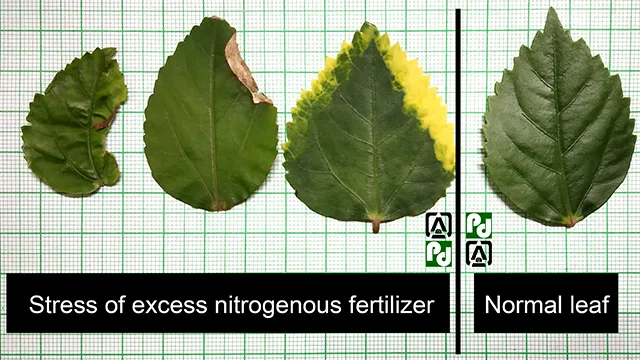Nitrogen deficiency in plants
Roles of nitrogen in plants
Nitrogen is one among the three most important nutrients so-called NPK (nitrogen, phosphorus and potassium). It is the limiting factor for the growth and development in plants, as its concentration is directly related to the chlorophyll contents in the leaves and photosynthetic efficiency. Nitrogen is required to promote the rapid growth of plants, during the fruit and seed development. It also increases the size and quality of the leaves.
Plants absorb nitrogen in the form of ammonium and nitrate. Nitrogen is highly mobile in plants as well as in soils and when provided in excess, it is leached in the soil and run-off to the water table.
Plants absorb nitrogen in the form of ammonium and nitrate. Nitrogen is highly mobile in plants as well as in soils and when provided in excess, it is leached in the soil and run-off to the water table.
Deficiency symptoms of nitrogen in plants
Plants deficient in nitrogen show following symptoms:
- Chlorosis (yellowing) starts from the older leaves and proceed towards the younger leaves.
- Whole plant appears yellowish or light green.
- Growth is stunted.
- If untreated, leaves turn brown and die.
- The productivity is highly reduced, mainly because of reduced photosynthesis.
Application of nitrogenous fertilizer
Nitrogen is essentially required for plants growth. Its deficiency is treated by the application of fertilizers available in the market. Some of the nitrogenous fertilizers are ammonium sulfate, ammonium chloride, sodium nitrate, potassium nitrate, calcium nitrate, urea, etc. In India urea is readily available and mostly commonly used nitrogenous fertilizer. According to a report, India alone uses about 350 lakh ton of urea per year.
Dose of nitrogenous fertilizer
Dose and frequency of nitrogenous fertilizer vary from crop to crop. In most of the cases its dose ranges between 134 to 179 kg/ha. According to an study carried out by Djaman et al. (2018), application of 150 kg urea per hectare in rice gave optimum result.
According to the Hoagland's solution recipe, optimum dose of nitrogen in soil less plant growth medium is 210 ppm (mg/l).
According to the Hoagland's solution recipe, optimum dose of nitrogen in soil less plant growth medium is 210 ppm (mg/l).
Excess dose of nitrogenous fertilizer
Excess dose of nitrogenous fertilizer has negative impacts on plants. If the concentration of nitrogen is exceeded plant exhibit following symptoms:
 |
| Leaves of china rose showing yellowing, curling and burning of leaves margin caused by excess nitrogenous fertilizer application |
- Leaves become rigid and dark green colored.
- Flowering is delayed or aborted.
- Leaves margin become yellow.
- Leaves start browning and curling at tip and eventually die.
- Plants become susceptible to diseases and stress.
- Root growth is retarded
When and how to apply nitrogenous fertilizer?
Nitrogen deficiency in plant can be corrected by the application of nitrogenous fertilizer. The fertilizer should be applied only when needed. Nitrogen status is plants can be judged by using 'chlorophyll meter' or 'leaf color chart'.
Nitrogenous fertilizers can be applied in the soil. As it is soluble in water, it can be applied with irrigation or as foliar spray. In foliar spray its optimum concentration is 1 % (1 g of urea per 100 ml of water).
Indian Farmers Fertiliser Cooperative Limited (IFFCO), India has developed 'Nano-Urea' liquid. IFFCO has conducted about 11,000 tests on more than 94 crops and found 8 % average increase in the productivity. The liquid contains 40,000 ppm urea and 500 ml of this liquid is as efficient as 50 Kg Urea.
Nitrogenous fertilizers can be applied in the soil. As it is soluble in water, it can be applied with irrigation or as foliar spray. In foliar spray its optimum concentration is 1 % (1 g of urea per 100 ml of water).
Indian Farmers Fertiliser Cooperative Limited (IFFCO), India has developed 'Nano-Urea' liquid. IFFCO has conducted about 11,000 tests on more than 94 crops and found 8 % average increase in the productivity. The liquid contains 40,000 ppm urea and 500 ml of this liquid is as efficient as 50 Kg Urea.
References
- Djaman K, Mel VC, Ametonou FY, Namaky RE, Diallo MD, et al. (2018) Effect of Nitrogen Fertilizer Dose and Application Timing on Yield and Nitrogen Use Efficiency of Irrigated Hybrid Rice under Semi-Arid Conditions. J Agri Sci Food Res 9: 223.
Content first created on 27-05-2021
last updated on 04-06-2021
last updated on 04-06-2021

